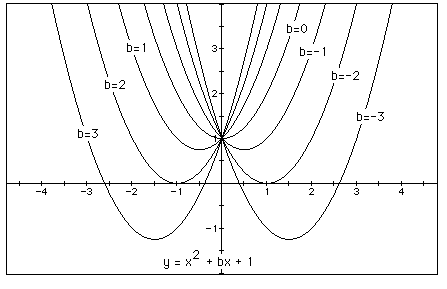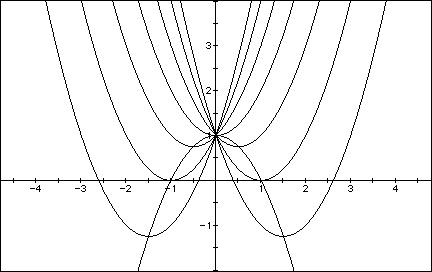

It has now become a rather standard exercise, with availble
technology, to construct graphs to consider the equation
and to overlay several graphs of
for different values of a, b, or c as the other two are held
constant. From these graphs discussion of the patterns for the
roots of
can be followed. For example, if we set
for b = -3, -2, -1, 0, 1, 2, 3, and overlay the graphs, the
following picture is obtained.

We can discuss the "movement" of a parabola as b
is changed. The parabola always passes through the same point
on the y-axis ( the point (0,1) with this equation). For b <-2,
the parabola will intersect the x-axis in two points with positive
x values (i.e. the original equation will have two real roots,
both positive). For b = -2, the parabola is tangent to the x-axis
and so the original equation has one real and positive root at
the point of tangency. For -2 < b < 2, the parabola does
not intersect the x-axis -- the original equation has no real
roots. Similarly for b = 2 the parabola is tangent to the x-axis
(one real negative root) and for b > 2, the parabola intersets
the x-axis twice to show two negative real roots for each b.
Now consider the locus of the vertices of the set of parabolas
graphed from
Show that the locus is the parabola
Generalize.

Consider again the equation
Now graph this relation in the xb plane. We get the following
graph.

If we take any particular value of b, say b = 3, and overlay
this equation on the graph we add a line parallel to the x-axis.
If it intersects the curve in the xb plane the intersection points
correspond to the roots of the original equation for that value
of b. We have the following graph.

For each value of b we select, we get a horizontal line. It
is clear on a single graph that we get two negative real roots
of the original equation when b > 2, one negative real root
when b = 2, no real roots for -2 < b < 2, One positive real
root when b = -2, and two positive real roots when b < -2.
Consider the case when c = - 1 rather than + 1.

For the case where c is negative, it appears that we get one positive root and one negative root for all values of b. As the values for b get very large, the positive root approaches 0 and the negative root approaches negative infinity. As the values for b get very small, the negative root approaches 0 and the positive root approaches positive infinity.
Graphs in the xa plane.
In the following example, the equation:
is considered. This graph produces a hyperbola. As we consider different values for y and graph them, these will be lines intersecting the hyperbola and these intersection points will be the roots for those values of a in the original equation. Let us look at the graph for different values of y:

From the graph, it appears that when a has negative values, this produces one positive and one negative root for the original equation. When a =o, their is one root at -1. For positive values of a only one root is produced and it will be negative.
In the following example the equation
is considered. This graph will produce a parabola. Let us consider different values for y which will be horizontal lines crossing our parabola. The intersection points between these lines and the parabola will be the roots for those values of c in our original equation. Let us look at such a graph:

For negative values of c, we again produce one negative
and one positive root, similar in nature to our graph in the xa
plane. However, we differ her in this plane for c=o,
where we produce two roots instead of one, we still get the -1
root and add to it the root of 0. As the c values start
to become positive, we produce two negative roots. There is a
maximum positive value for c, where we get just one negative
root of -0.5and any greater values of c produce no more
roots. This value for c is 0.25.